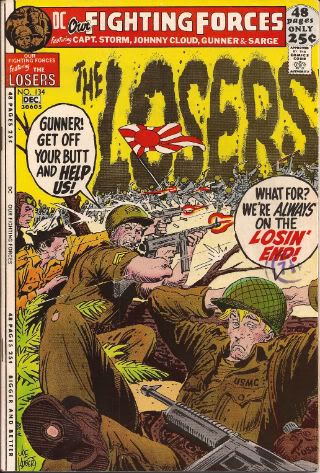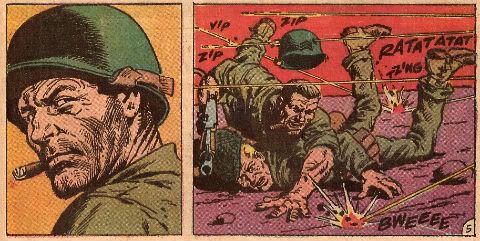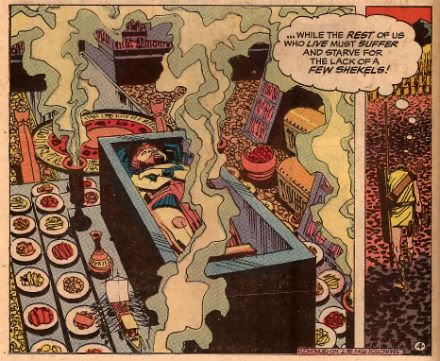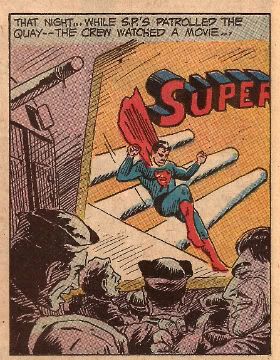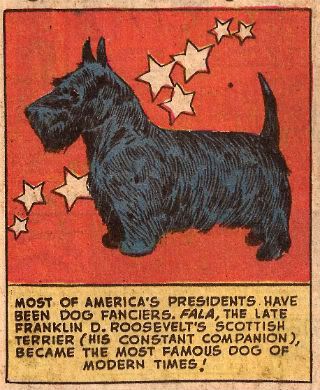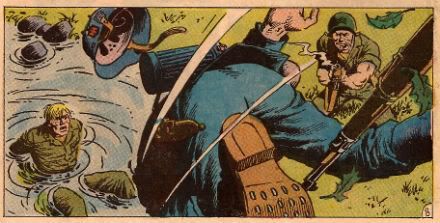"Watch Yer Noggin!" Comics! Sometimes They Are About Losers!
/I read an old ‘70s DC war comic and I liked what I saw. Because what I saw was drawn by Joe Kubert, Alex Toth, Sam Glanzman and John Severin. I am good to my eyes. It cost 25 cents. Well, in 1971 it did.
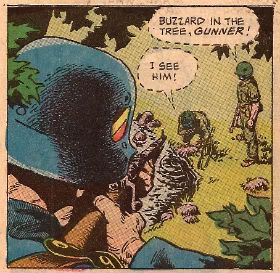
OUR FIGHTING FORCES # 134 By John Severin, Alex Toth, Joe Kubert & Sam Glanzman (a) with Robert Kanigher (w), lettering (probably) by the artists and colours by U.N. Known. The colourist no one knows but is known to everyone! Ho! DC Comics, Nov-Dec 1971, 25 cents (7½ pence)
"Joe Kubert edited this so if he wants Japanese soldiers on the cover when there are none inside, By God, there will be Japanese soldiers on the cover!"
It’s probably untrue to say that OUR FIGHTING FORCES (OFF) isn't anyone’s favourite comic but you could probably fit all the people who’d choose OFF before all other comics into the snug of a small pub. Personally I chanced upon this issue due to a weakness I have for smelly, yellowing non-tights’n’fights ‘70s mainstream genre comics. Sure, some men have a weakness for dangerous women or the thrill of the hunt but that’s their loss. I wasn't expecting much is what I’m saying. But what I got was Toth, Kubert, Glanzman and Severin. And I also learned some exciting facts about dogs.
"An awesome pause and then - mad shit busts loose - it's SEVERIN!"
Robert Kanigher writes all the tales between these two tatty covers and if any one man personified DC’s war comics it is Joe Kubert. But after Joe Kubert it is definitely Robert Kanigher. Now while on a purely human level it seems Kanigher was certainly “difficult” on a professional level he was certainly, well, professional. Unlikely to be critically lauded anytime soon Kanigher could not only fill pages but, even better, he could fill lots of pages and better still he could do it without surcease. Robert Kanigher was a writer when a comic writer’s job was to write and no one can deny the fact he did that. When Joe Kubert replaced Kanigher as DC’s war books editor Kubert kept Kanigher on as writer. Whatever ill feeling there was Kubert did what it took to deal with it in order to keep the man he felt was best suited to the job. That’s a pretty solid tribute to the man’s talents. Either man. Anyway, Kanigher could churn this stuff out and like anyone who ends up as a churner the results were mostly mediocre with the odd brush with greatness and far more belly-flops into incoherence. Given the rate at which he pumped this stuff out it’s also easy to spot his style so although the last story here (“Number One”) is not credited to a writer I’m pretty sure it’s Robert Kanigher.
"Wait 'til he sees her teeth. (British people's teeth - comedy GOLD!)"
If it isn't Robert Kanigher my gast will be flabbered because the story is very, very Robert Kanigher. It’s a variation on his old standby of someone repeating a phrase embodying something they want to do while the events of the story conspire to prevent them and usually leading up to an ironic ending. Where “ironic” usually means “coincidental” rather than “ironic". It also has another signature Kanigher move – the lone soldier who pretty much unfeasibly kills his way to the end while the threats ascend in scale and danger; here our plucky dogface bests a plane, a gunboat, a U-boat and finally a pill box with three ’88 guns. That’s not bad for one grunt. I’d guess this one isn't writer-credited because it’s a reprint (the page filling banner across the top clues you in) but Joe Kubert has stuck his name on the art. This is lucky because it looks a bit like he was in a rush and so it resembles the work of someone who has just left The Kubert School rather than someone who will soon open the Kubert School. It’s OKAY!
"There's practically nothing there but everything essential is there - it's TOTH!"
Preceding Number One there is “Soldier’s Grave” by Robert Kanigher and Alex Toth. Yeah. Alex Toth. Not much to say really as it’s Alex Toth so the page designs and layouts are wonderful, the brevity with which he visually communicates the necessary information is borne of skill rather than sloth and, look, it’s Alex Toth. Kanigher’s tale tells of an aged Egyptian who joins the Pharaoh's armies so that the pay he will receive on fighting will take care of his family. Now, I’m a Dad and a Partner while also having, shall we say, a certain Autumnal mental aspect so that kind of stuff gets in me and hurts. The poor sucker can’t make it into the fight (so his family won’t get any moolah) but luckily he lucks into holding up the Persians while his forces retreat. This costs him his life but the Eygptian leader promises to see his family right by giving them the valuable dagger that slew their paterfamilias. Again, I think Kanigher is reaching for irony here but ends up kind of edging more into the area where the dagger is a symbol for a kind of old timey Death In Service payment. It’s not a terribly convincing ending but there is an effective playing up of the disgusting waste of the Pharaoh and the parlous state in which his subjects live. It’s kind of clever really. With the exception of one panel the story shows just desert, pyramids, rocks and soldiers; it’s barren and harsh and then there’s the single panel showing the Pharaoh's tomb filled with food and loot. It would of course be cleverer without the big word balloon spelling it out for us but back then over-egging the pudding was par for the course. So, Kanigher’s script is okay but Toth’s art lifts it up to VERY GOOD!
"It's okay all that'll end up in a British museum - because we are stealers!"
Sam Glanzman’s U.S.S. Stevens’ tale “In Tsingtao” takes us almost to the front of the book and, like all it’s author’s work, it has a lot of heart that makes up for most of the rough edges. Glanzman actually served aboard the U.S.S. Stevens during 1941 – 45 and I believe (although you may correct me) that these stories certainly draw upon his experiences if not actually document said experiences. It’s knowing this that lends a certain generosity to my reception of the strip. While I might otherwise be unimpressed by what appears a muddled attempt to contrast the comic book mythology of Superman’s invulnerability with the very real vulnerability of four sailors slain on shore leave; knowing it is probably based on a real event means that I can be more impressed by it as an attempt to embody the sadness and waste of such an event and that reading more into the panel where the sailors watch a Superman serial than the fact that sailors used to watch Superman serials is entirely my fault. Which is a long and tedious way of saying In Tsingtao is short and affecting and GOOD!
"Man, I bet the guys who created Superman died rich!"
Luckily any reader will have been prepared for Glanzman’s depressing tale by the feel-good fun facts of “Canine Corner”! This is two pages of dog facts and pictures which are linked to the military theme of the book by the fact that some dogs were used by the Army as they could “giving warning of enemy infiltration at night”. i.e. they barked.
"For Mr. Graeme 'The Dog Botherer' McMillan"
Which brings us to the tale at the front of the book - “The Real Losers!” I have worked my way backwards because like the immortal Vanessa Williams song I like to leave the best ‘til last. This isn't the best story because of Robert Kanigher’s script but because of John Severin’s art. The script is basically an excuse to build to a scene where Gunner (the young blonde Loser) rediscovers his will to fight the good fight. Like all Kanigher’s war scripts the plot has little to do with reality but for it to work it has to at least appear to be grounded in reality. Given Kanigher’s shortcomings as a writer this is a task the art has to shoulder. John Severin’s performance on these pages is more than suited to the task. I like to group Severin amongst my personal roster of Quiet Giants of Comic Art. He rarely appears on anyone’s best of list but he certainly deserves to. It’s probable that working with the inestimable Harvey Kurtzman on EC’s war stories cemented in Severin a certainty that research and authenticity were essential to successful verisimilitude. See this panel from pg.8:
Now I've read a lot of war comics so I've probably seen more bullet riddled German soldiers fall out of trees than is strictly healthy but what strikes me about that panel is the level of detail. The insignia on the helmet is clearly visible, attention has been paid to the studs on the soles of the boots and, best of all, Severin has drawn the lining in the helmet. Now I’m not a WW2 obsessive so I can’t vouch for the veracity of these elements but the wealth of them convinces me of the reality of the image and makes me shake my head in admiration at the effort that could have been so easily avoided but wasn't. Later (pg.13) Severin draws a bunch of howling Wehrmacht bursting from a landing craft. According to a WW2 obsessive and pedant (how often the two are paired!) I once worked with it seems holding a Schmeisser by the ammo clip wouldn't work due to its instability when firing. So, I’m not unaware that Severin gets things wrong but the things he gets wrong are the things everyone gets wrong and the things he gets right are things most artists wouldn't even bother about.
But Severin isn't just about the detail, which in isolation would make his work err towards the clinical, but also about body language and expressions and it’s these that give his work heart. By pg.11 Gunner and Sarge are on a beach with a bunch of walking wounded when they are made aware of an impending German attack. At this point Gunner still won’t pick up his gun to fight but at the OIC’s command of “Walking wounded!—Grab your weapons and form a line at the water’s edge!” Kanigher steps back and lets Severin’s lines speak with dignity and sureness:
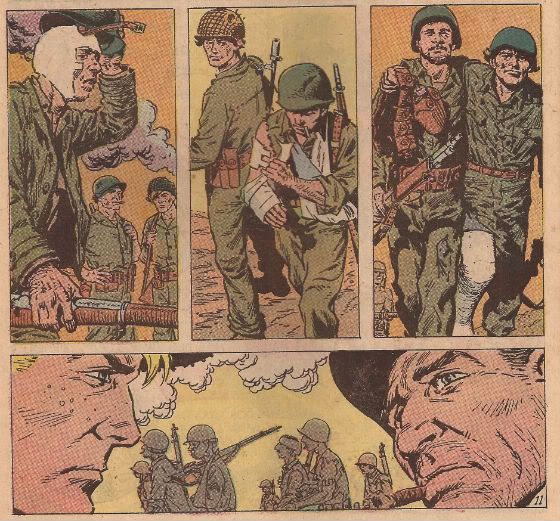 Of course Kanigher has to spoil it on the next page with some customarily hilarious over-egging (“Who needs FEET to SQUEEZE a TRIGGER!”) but look at that last horizontal panel. Look at Sarge’s face; his expression. That’s a complex piece of “acting” right there. It’s class and John Severin is a class act all the way. It’s a sad thing that such excellent work has to be stumbled upon in back issue bins by accident. But it’s a good thing I did because I got to tell you about it. Assuming you’re still here. John Severin’s excellent work lifts The Real Losers! up to VERY GOOD!
Of course Kanigher has to spoil it on the next page with some customarily hilarious over-egging (“Who needs FEET to SQUEEZE a TRIGGER!”) but look at that last horizontal panel. Look at Sarge’s face; his expression. That’s a complex piece of “acting” right there. It’s class and John Severin is a class act all the way. It’s a sad thing that such excellent work has to be stumbled upon in back issue bins by accident. But it’s a good thing I did because I got to tell you about it. Assuming you’re still here. John Severin’s excellent work lifts The Real Losers! up to VERY GOOD!
So there’s an old DC war comic I wasn't expecting anything from but got a Hell of a blast out of. And me? Like The Pharoahs I'm history!
Have a nice weekend all a youse stumblebums!


